ผลของอัตราไหลแก๊สไนโตรเจนต่อโครงสร้างของฟิล์มบางวาเนเดียมไนไตรด์ ที่เคลือบด้วยวิธีรีแอคทีฟดีซีแมกนีตรอนสปัตเตอริง Effect of N2 Gas Flow Rate on Structure of VN Thin Films Deposited by Reactive DC Magnetron Sputtering Method
Main Article Content
Abstract
บทคัดย่อ
ฟิล์มบางวาเนเดียมไนไตรด์ (VN) เคลือบบนกระจกสไลด์และซิลิกอนด้วยวิธีรีแอคทีฟดีซีแมกนีตรอน
สปัตเตอริง เพื่อศึกษาผลของอัตราไหลแก๊สไนโตรเจนในช่วง 2.0 - 8.0 sccm ต่อโครงสร้างของฟิล์มที่ได้
โดยโครงสร้างผลึก ความหนา ความหยาบผิว ลักษณะพื้นผิวและองค์ประกอบทางเคมีของฟิล์ม ศึกษาด้วย
เทคนิคการเลี้ยวเบนรังสีเอกซ์ กล้องจุลทรรศน์แรงอะตอม กล้องจุลทรรศน์อิเล็กตรอนแบบส่องกราด
และการวิเคราะห์การกระจายพลังงานของรังสีเอกซ์ ตามลำดับ ผลการศึกษาพบว่าฟิล์มวาเนเดียมไนไตรด์
ที่เคลือบได้มีโครงสร้างผลึกแบบ fcc ระนาบ (111) (200) (220) และ (311) แปรตามอัตราไหลแก๊สไนโตรเจน
ขนาดผลึกและค่าคงที่แลตทิชของฟิล์มมีค่าในช่วง 47 - 77 nm และ 4.107 - 4.127 ตามลำดับ
ส่วนความหนาและความหยาบผิวของฟิล์มมีค่าลดลงตามอัตราไหลแก๊สไนโตรเจนที่เพิ่มขึ้น จาก 1415 nm
เป็น 859 nm และ 26 nm เป็น 12 nm ตามลำดับ จากผลการวิเคราะห์ภาคตัดขวางด้วยกล้องจุลทรรศน์
อิเล็กตรอนแบบส่องกราด แสดงให้เห็นว่าฟิล์มที่เคลือบได้มีโครงสร้างแบบคอลัมนาร์และมีลักษณะ
พื้นผิวที่แน่นขึ้นเมื่ออัตราไหลแก๊สไนโตรเจนเพิ่มขึ้น ทั้งนี้ฟิล์มที่เคลือบได้มีวาเนเดียมและไนโตรเจนเป็น
ส่วนประกอบในอัตราส่วนต่าง ๆ แปรค่าตามอัตราไหลแก๊สไนโตรเจน
Abstract
Vanadium Nitride (VN) thin films were deposited on glass slide and silicon by reactive
DC magnetron sputtering method. The effect of N2 gas flow rate, in the range of 2.0 - 8.0 sccm,
on the structure of the as-deposited films was investigated. The crystal structure,
thickness, roughness, surface morphology and chemical composition were characterized
by X-Ray Diffraction (XRD), Atomic Force Microscopy (AFM), Field Emission Scanning
Electron Microscopy (FE-SEM) and Energy Dispersive X-Ray Spectroscopy (EDS),
respectively. The results showed that the as-deposited VN thin films had fcc structure
with (111), (200), (220) and (311) planes, varying with the N2 gas flow rate. The crystallite
size and lattice constant were in the range of 47 - 77 nm and 4.107 - 4.127 , respectively.
The film thickness and roughness decreased with increasing N2 gas flow rate, from
1415 nm to 859 nm and 26 nm to 12 nm, respectively. Cross section analysis by FE-SEM
showed a compact columnar structure and dense morphology as a result of increasing
the N2 gas flow rate. The as-deposited films compose of vanadium and nitrogen in
different ratios, depending on the N2 gas flow rate.
Article Details
References
of Mean Free Path on th Preferentially Orientated Growth of AlN Thin Films.
Journal of Crystal Growth. Vol. 283. pp. 315-319
D’Anna, E., Cristoforo, A.D., Fern ndez, M., Leggieri, G., Luches, A., Majni, G., Mengucci, P.
and Nanai, L. (2002). Excimer Laser Reactive Deposition of Vanadium Nitride
Thin Films. Applied Surface Science. Vol. 186. No. 1-4. pp. 496-501
Glaser, A., Surnev, S., Netzer, F., Fateh, N., Fontalvo, G. and Mitterer, C. (2007). Oxidation
of Vanadium Nitride and Titanium Nitride Coatings. Surface Science. Vol. 601.
No. 4. pp. 1153-1159
Gueddaoui, H., Schmerber, G., Abes, M., Guemmaz, M. and Parlebas, J.C. (2006). Effects
of Experimental Parameters on the Physical Properties of Non-Stoichiometric
Sputtered Banadium Nitrides Films. Catalysis Today. Vol. 113. pp. 270-274
Lim, J.W., Park, J.S. and Kang, S.W. (2000). Kinetic Modeling of Film Growth Rates of TiN
Films in Atomic Layer Deposition. Journal of Applied Physics. Vol. 87. pp. 4632-4634
Liu, X., Huibin, L., Meng, H., Kuijuan, J., Guozhen, Y., Hao, N. and Kun, Z. (2014).
Epitaxial Growth of Vanadium Nitride Thin Films by Laser Molecule Beam
Epitaxy. Materials Letters. Vol. 123. pp. 38-40
Lugscheider, E., Knotek, O., Bobzin, K. and Barwulf, S. (2000). Tribological Properties,
Phase Generation and High Temperature Phase Stability of Tungsten- and
Vanadium-Oxides Deposited by Reactive MSIP-PVD Process for Innovative
Lubrication Applications. Surface and Coatings Technology. Vol. 133-134. pp. 362-368
Ma, C.H., Huang, J.H. and Chen, H. (2000). A Study of Preferred Orientation of Vanadium
Nitride and Zirconium Nitride Coatings on Silicon Prepared by Ion Beam Assisted
Deposition. Surface and Coatings Technology. Vol. 133-134. pp. 289-294
Massalski, T.B. (1991). Binary Alloy Phase Diagrams. Ohio : ASM Metals Park.
Musil, J., Baroch, P., Vlcek, J., Nam, K.H. and Han, J.G. (2005). Reactive Magnetron
Sputtering of Thin Films: Present Status and Trends. Thin Solid Film. Vol. 475.
pp. 208-218
Shi, P.Z., Wang, J., Tian, C.X., Li, Z.G., Zhang, G.D., Fu, D.J. and B. Yang. (2013). Structure,
Mechanical and Tribological Properties of CrN Thick Coatings Deposited by
Circular Combined Tubular Arc Ion Plating. Surface and Coatings Technology.
Vol. 288. pp. S534-S537
Sproul, W.D., Christie, D.J. and Carter, D.C. (2005). Control of Reactive Sputtering
Processes. Thin Solid Film. Vol. 49. pp. 1-17
Wiklund, U., Casas, B. and Stavlid, N. (2006). Evaporated Vanadium Nitride as a Friction
Material in Dry Sliding Against Stainless Steel. Wear. Vol. 261. pp. 2-8
Zhang, S., Deen, S., Youngqing, F. and Hejun, D. (2003). Recent Advances of Superhard
Nanocomposited Coaitngs: a Review. Surface and Coatings Technology. Vol. 167.
pp. 113-119

